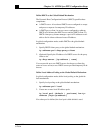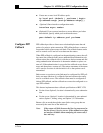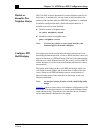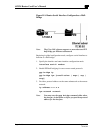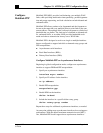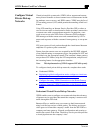
Chapter 11: AI2524 Sync PPP Configuration Steps
August 1997 Page 11-19
2524UM
Configure
Multilink PPP
Multilink PPP (MLP) provides load balancing over multiple WAN
links, while providing multivendor interoperability, packet fragmenta-
tion and proper sequencing, and load calculation on both inbound and
outbound traffic.
Multilink PPP allows packets to be fragmented and the fragments to
be sent at the same time over multiple point-to-point links to the sam
remote address. The multiple links come up in response to a dialer load
threshold that you define. The load can be calculated on inbound traf-
fic, outbound traffic, or on either. MLP provides bandwidth on de-
mand and reduces transmission latency across WAN links.
Multilink PPP is designed to work over single or multiple interfaces
that are configured to support both dial-on-demand rotary groups and
PPP encapsulation:
z
Asynchronous serial interfaces
z
Basic Rate Interfaces (BRIs)
z
Primary Rate Interfaces (PRIs)
Configure Multilink PPP on Asynchronous Interfaces
Beginning in global configuration mode, configure an asynchronous
interface to support DDR and PPP encapsulation:
1. Specify an asynchronous interface.
interface async
number
2. Specify no IP address for the interface.
no ip address
3. Enable PPP encapsulation.
encapsulation ppp
4. Enable DDR on the interface.
dialer in-band
5. Include the interface in a specific dialer rotary group.
dialer rotary-group
number
Repeat these steps for additional asynchronous interfaces, as needed.
At some point, adding more asynchronous interfaces does not improve
performance. With the default maximum transmission unit (MTU)
size, Multilink PPP should support three asynchronous interfaces



